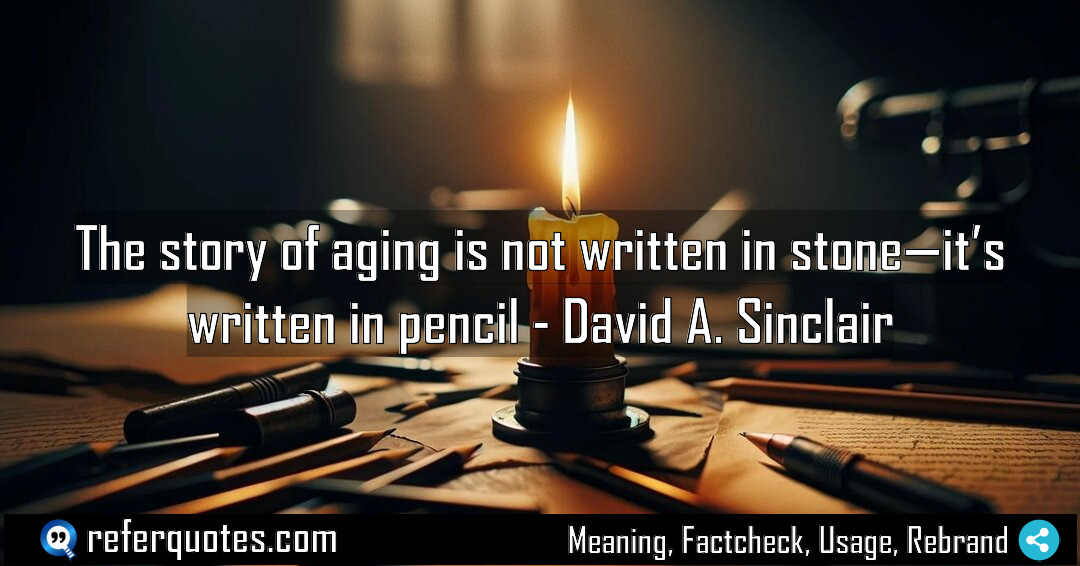
You know, the story of aging is not written in stone really flips the script on everything we thought we knew about getting older. It’s not some fixed, unchangeable destiny we’re all just marching towards. It’s more like a draft you can actively edit, which is a pretty empowering way to look at your health and your future, honestly.
Share Image Quote:
Table of Contents
Meaning
The core idea is that our biological age isn’t a fixed, unchangeable fact. It’s malleable. We have a significant degree of control over how we age.
Explanation
Let me break this down for you. For the longest time, we thought aging was like a stone carving—permanent, etched by our genes, and that was that. You just had to accept it. What Sinclair is saying, based on decades of research, is that it’s more like a pencil sketch. Yeah, there’s a default outline there, but you can erase parts of it. You can redraw lines. You can smudge it and create something new. The science of epigenetics shows that our lifestyle, our environment, they’re the hands holding the eraser and the pencil, constantly revising the story of our cells. It’s a fundamentally optimistic view of human biology.
Quote Summary
Reading Level80
Aesthetic Score90
Origin & Factcheck
This comes straight from David Sinclair’s 2019 book, Lifespan: Why We Age—and Why We Don’t Have To. He’s a professor of genetics at Harvard Medical School, so this isn’t just a catchy phrase—it’s the thesis of his life’s work. You won’t find it mistakenly attributed to anyone else; this is pure Sinclair.
Attribution Summary
Where is this quotation located?
| Quotation | The story of aging is not written in stone—it’s written in pencil |
| Book Details | Publication Year: 2019; ISBN: 978-1501191978; Last edition: 2020; Number of pages: 432. |
| Where is it? | Chapter 3: Longevity Now, Approximate page 111 from 2019 edition |
Context
In the book, he uses this analogy to introduce the concept of the “Information Theory of Aging.” He argues that aging is primarily a loss of epigenetic information—the cellular instructions that tell a skin cell to be a skin cell and not a liver cell. This loss is what he considers the “pencil” writing, the part that’s malleable and, crucially, potentially reversible.
Usage Examples
I find myself using this all the time. For instance, when I’m talking to a client who’s feeling defeated about turning 40 and thinks their best years are behind them. I tell them, “Look, your story is written in pencil, not stone. The choices you make today about sleep, nutrition, and exercise? That’s you grabbing the eraser.” It’s perfect for motivating people in health and wellness, or even just anyone who needs a nudge to take control of their long-term well-being.
To whom it appeals?
Share This Quote Image & Motivate
Motivation Score85
Popularity Score84
Shareability Score90
Common Questions
Question: Is this just a metaphor, or is there real science behind it?
Answer: Oh, it’s absolutely grounded in real science, specifically in the field of epigenetics. It’s the study of how your behaviors and environment can cause changes that affect the way your genes work, without changing the DNA sequence itself. That’s the “pencil.”
Question: So does this mean we can stop aging entirely?
Answer: Not stop, no. The book’s title is “Lifespan,” not “Immortality.” The goal isn’t to live forever, but to have a *healthspan* that matches our lifespan. To be vibrant and healthy for as long as we’re alive. It’s about compressing the period of decline.
Question: What’s the “eraser” in this analogy?
Answer: Great question. The “eraser” is the collection of interventions—like certain diets (e.g., intermittent fasting), specific nutrients, exercise, and even emerging pharmaceuticals—that have been shown to influence epigenetic markers and potentially slow or reverse aspects of the aging process.
Similar Quotes
You know, when David Sinclair says “Aging is a loss of information,” he’s flipping the script on how we see getting older. It’s not about time running out, but about…
You know, that idea that “Aging is not destiny—it’s design” really flips the script on how we think about getting older. It’s not some predetermined fate we just have to…
You know, when David Sinclair says “Aging isn’t a failure of the body,” he’s completely flipping the script. It’s not about our biology letting us down, but about our own…
You know, “The science of aging is the science” of flipping the script on everything we thought we knew. It’s not about getting old gracefully; it’s about actively fighting to…
To slow aging, we must first change our minds. It’s a profound shift from seeing aging as an inevitable decline to viewing it as a malleable process we can influence.…
